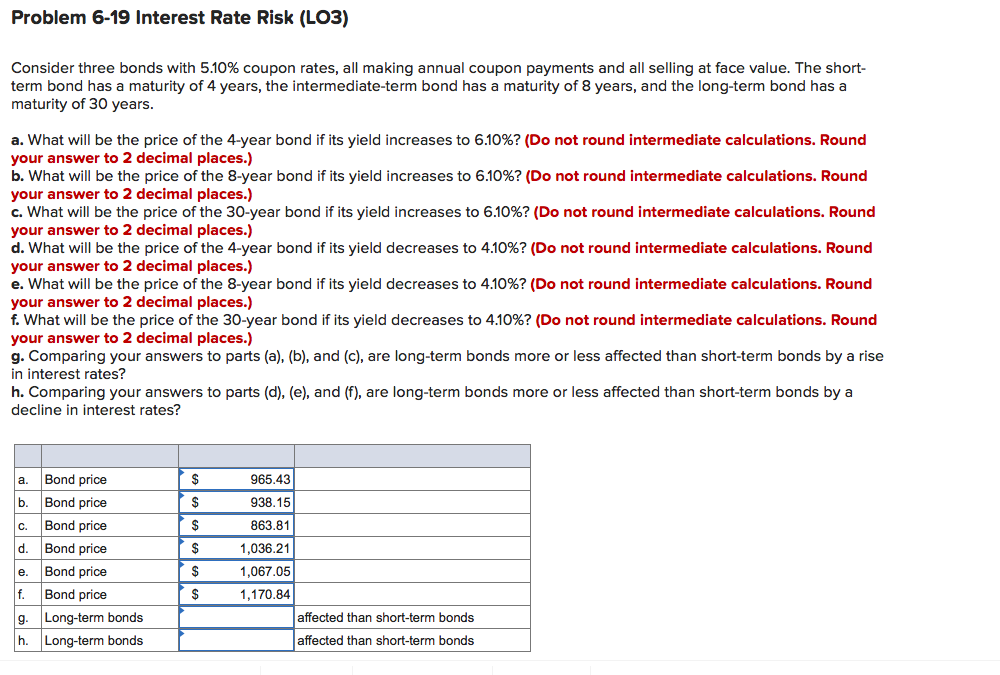Consider three bonds with 5.10% coupon rates, all making annual coupon payments and all selling at face value. The short- term bond has a maturity of 4 years, the intermediate-term bond has a maturity of 8 years, and the long-term bond has a maturity of 30 years. a. What will be the price of the 4-year bond if its yield increases to 6.10%? (Do not round intermediate calculations. Round your answer to 2 decimal places.) b. What will be the price of the 8-year bond if its yield increases to 6.10%? (Do not round intermediate calculations. Round your answer to 2 decimal places.) c. What will be the price of the 30-year bond if its yield increases to 6.10%? (Do not round intermediate calculations. Round your answer to 2 decimal places.)
Consider three bonds with 5.10% coupon rates, all making annual coupon payments and all selling at face value. The short- term bond has a maturity of 4 years, the intermediate-term bond has a maturity of 8 years, and the long-term bond has a maturity of 30 years. a. What will be the price of the 4-year bond if its yield increases to 6.10%? (Do not round intermediate calculations. Round your answer to 2 decimal places.) b. What will be the price of the 8-year bond if its yield increases to 6.10%? (Do not round intermediate calculations. Round your answer to 2 decimal places.) c. What will be the price of the 30-year bond if its yield increases to 6.10%? (Do not round intermediate calculations. Round your answer to 2 decimal places.)
Chapter5: The Cost Of Money (interest Rates)
Section: Chapter Questions
Problem 20PROB
Related questions
Question

Transcribed Image Text:Problem 6-19 Interest Rate Risk (LO3)
Consider three bonds with 5.10% coupon rates, all making annual coupon payments and all selling at face value. The short-
term bond has a maturity of 4 years, the intermediate-term bond has a maturity of 8 years, and the long-term bond has a
maturity of 30 years.
a. What will be the price of the 4-year bond if its yield increases to 6.10%? (Do not round intermediate calculations. Round
your answer to 2 decimal places.)
b. What will be the price of the 8-year bond if its yield increases to 6.10%? (Do not round intermediate calculations. Round
your answer to 2 decimal places.)
c. What will be the price of the 30-year bond if its yield increases to 6.10%? (Do not round intermediate calculations. Round
your answer to 2 decimal places.)
d. What will be the price of the 4-year bond if its yield decreases to 4.10%? (Do not round intermediate calculations. Round
your answer to 2 decimal places.)
e. What will be the price of the 8-year bond if its yield decreases to 4.10%? (Do not round intermediate calculations. Round
your answer to 2 decimal places.)
f. What will be the price of the 30-year bond if its yield decreases to 4.10%? (Do not round intermediate calculations. Round
your answer to 2 decimal places.)
g. Comparing your answers to parts (a), (b), and (c), are long-term bonds more or less affected than short-term bonds by a rise
in interest rates?
h. Comparing your answers to parts (d), (e), and (f), are long-term bonds more or less affected than short-term bonds by a
decline in interest rates?
Bond price
$
965.43
a.
b.
Bond price
$
938.15
Bond price
$
863.81
с.
d.
Bond price
$
1,036.21
e.
Bond price
$
1,067.05
f.
Bond price
$
1,170.84
g.
Long-term bonds
affected than short-term bonds
h.
Long-term bonds
affected than short-term bonds
Expert Solution
This question has been solved!
Explore an expertly crafted, step-by-step solution for a thorough understanding of key concepts.
This is a popular solution!
Trending now
This is a popular solution!
Step by step
Solved in 2 steps with 2 images

Recommended textbooks for you

